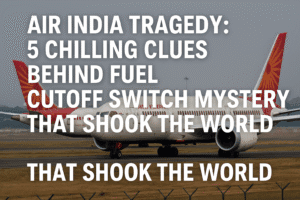Air India Tragedy: 5 Chilling Clues Behind Fuel Cutoff Switch Mystery That Shook the World
The tragic crash of Air India Flight 171 has left behind a mystery that goes beyond mechanical failure and into deeply human territory. Preliminary findings reveal that fuel cutoff switches were deliberately turned off moments before the crash, yet cockpit audio captures one pilot denying any such action. This contradiction has triggered intense scrutiny—raising the possibility of accidental switch activation, miscommunication, or even an undetected technical fault. The pilots fought valiantly to restart the engines, showing this was not a calculated act.
With 270 lives lost and only one survivor, the emotional and societal impact is immense. While maintenance flaws in India’s aviation sector raise systemic questions, investigators are carefully examining every detail—from the pilots’ mental states to Dreamliner systems—to find definitive answers. As the first fatal incident involving a Boeing 787, this catastrophe commands global attention. In the end, the story is one of human error, resilience, and grief, with the world waiting not just for facts, but for justice and reform.

Air India Tragedy: 5 Chilling Clues Behind Fuel Cutoff Switch Mystery That Shook the World
The devastating crash of Air India Flight 171 on June 12th, 2025, remains a raw wound. The preliminary report released last week confirmed a chilling detail: the fuel cutoff switches for both engines were deliberately moved to “cutoff” seconds before the London-bound Boeing 787 plunged into Ahmedabad, claiming 270 lives. But this technical finding opens a chasm of human questions far deeper than a simple switch position.
The Stark Finding & Its Immediate Contradiction: The report is unequivocal: the switches controlling fuel flow to Engines 1 and 2 were physically changed from “RUN” to “CUTOFF” shortly after takeoff. This action would starve the engines of fuel, causing them to fail. The chilling human element emerges immediately from the cockpit voice recorder (CVR): one pilot asks the other why he cut off the fuel. The other pilot responds, “I did not do so.”
This single exchange transforms the tragedy from a potential mechanical failure into a profound human mystery. It forces us to confront unsettling possibilities:
- Unintentional Action: Could a pilot have accidentally bumped the guarded switches in a high-stress takeoff environment? While designed to prevent this, human factors experts know extreme stress can lead to unintended movements. The report notes subsequent, frantic attempts to relight the engines – actions inconsistent with a deliberate shutdown.
- Miscommunication or Misunderstanding: Did one pilot misinterpret the other’s actions or intentions? The query “why did he cutoff” suggests confusion existed in real-time.
- A Deeper, Unexplained Anomaly: Could there be an undiscovered system malfunction or external interference that mimicked or caused the switch movement? The preliminary nature of the report means all avenues remain open.
Beyond the Cockpit: Layers of Context and Concern: While the switches are the focal point, the report and surrounding context paint a broader, more complex picture:
- The Frantic Fight to Recover: Pilots didn’t passively accept engine failure. They attempted repeatedly to relight Engine 2 and witnessed Engine 1 showing signs of potential recovery before the fatal descent began. This underscores their struggle against an unforeseen catastrophe.
- The Unfathomable Human Cost: The statistics – 241 souls on the plane, only one survivor (Ramesh Viswashkumar), and 29 innocent lives lost on the ground – are numbing. Each number represents unimaginable grief for families worldwide.
- Regulatory Scrutiny & Maintenance Questions: While the DGCA’s initial checks on Air India’s Dreamliners found “no major concerns,” their subsequent audit revealed wider issues: “repeated defects on aircraft indicating ineffective monitoring and inadequate rectification action” across several airlines and airports. Air India Express (a subsidiary) also faces separate investigations regarding maintenance practices. This raises critical questions about the systemic safety culture within the Indian aviation sector, even if unrelated directly to this crash.
- A First for the Dreamliner: This tragedy marks the first fatal crash involving Boeing’s 787 Dreamliner, a jet lauded for its efficiency and advanced systems since 2011. The global aviation community watches intently.
The Path Forward: Grief, Patience, and the Demand for Truth: The preliminary report provides a crucial, but incomplete, piece of the puzzle. It tells us what happened with the switches but not how or why. The investigation’s complexity is immense:
- Black Box Analysis: Deeper decoding of the CVR and Flight Data Recorder (FDR) is paramount to understand crew actions, system responses, and the sequence of events in granular detail.
- Human Factors Scrutiny: The pilots’ training records, health, rest schedules, and any potential stressors will be meticulously examined.
- Technical Forensics: Every component related to the fuel cutoff system, cockpit controls, and engines will undergo exhaustive testing to rule out malfunction.
- Broader System Audit: The maintenance and oversight concerns flagged by regulators demand rigorous independent review.
The Enduring Human Insight: This tragedy transcends aviation mechanics. It is a story of sudden, catastrophic loss leaving hundreds of families shattered. The contradictory words captured in the cockpit – “why did he cutoff?” / “I did not do so” – echo as a haunting reminder of the human element at the heart of complex technology. They represent confusion and denial in the face of impending doom.
The sole survivor’s testimony and the ongoing grief of the bereaved remind us that behind every technical datum lies profound human suffering. The value for readers lies not just in understanding the switch position, but in recognizing the immense responsibility borne by those who design, maintain, and operate these machines, and the critical importance of relentless pursuit of safety at every level. The world waits, not just for conclusions, but for answers that can honor the lost and prevent such anguish from ever happening again. Patience and thoroughness are the only tributes worthy of this scale of loss.
You must be logged in to post a comment.